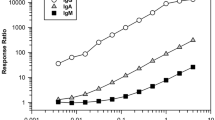Abstract
Biologics can potentially induce unwanted immune responses, leading to formation of antidrug antibodies (ADA) of various affinity, isotypes, and subclasses. Among them, antigen and drug-specific immunoglobulin E (IgE) antibodies have been reported to have potential correlation with hypersensitivity and anaphylaxis in particular. Recent regulatory guidance on immunogenicity testing has recommended the measurement of antigen-specific IgE antibodies for biologics with a reported high risk of anaphylaxis using assays with sensitivities in the high pg/mL to low ng/mL range. Nevertheless, IgE ADA remains challenging to detect due to their being the least abundant isotype in blood serum samples and the potential for interference in the bioanalytical methods due to high levels of endogenous immunoglobulin G (IgG) and immunoglobulin M (IgM) ADA, not to mention the nonspecific total serum IgE antibodies. Another challenge in developing IgE ADA assays is the need to create a surrogate drug-specific IgE antibody positive control to monitor the performance of the assay for the intended use. In this case study, utilizing a human IgE antidrug antibody positive control and a human IgE receptor as capture, an enzyme-linked immunosorbent assay (ELISA) method was developed for the measurement of IgE ADA, meeting the regulatory expectations, with excellent assay sensitivity, selectivity, specificity, and tolerance towards potential interference in serum samples. This assay format could be readily adapted and implemented to assess drug-specific IgE antibodies in the event of drug-related anaphylaxis in clinical and in nonclinical development programs.






Similar content being viewed by others
Change history
16 March 2020
During the production process, the author order of Zhandong Don Zhong and Lynn L. Jiang were inadvertently placed. Lynn L. Jiang is the first author of this manuscript; Zhandong Don Zhong is the last author.
References
Committee for Medicinal Products for Human Use (CHMP). Guideline on Immunogenicity assessment of therapeutic proteins; 2017.
US Food and Drug Administration (FDA). Guidance for Industry Immunogenicity Testing of Therapeutic Protein Products - Developing and Validating Assays for Anti-Drug Antibody Detection; 2019.
US Food and Drug Administration. Guidance for Industry Immunogenicity assessment for therapeutic protein products; 2014.
Sailstad JM, Amaravadi L, Clements-Egan A, Gorovits B, Myler HA, Pillutla RC, et al. A white paper--consensus and recommendations of a global harmonization team on assessing the impact of immunogenicity on pharmacokinetic measurements. AAPS J. 2014;16(3):488–98.
Chamberlain P. Effective presentation of immunogenicity risk assessments and related data in regulatory dossiers. Bioanalysis. 2019;11.
Corominas M, Gastaminza G, Lobera T. Hypersensitivity reactions to biological drugs. J Investig Allergol Clin Immunol. 2014;24:212–25.
Lieberman PL, Jones I, Rajwanshi R, Rosen K, Umetsu DT. Anaphylaxis associated with omalizumab administration: risk factors and patient characteristics. J Allergy Clin Immunol. 2017;140:1734–6.
Clinical and Laboratory Standards Institute. I/LA34-a design and validation of immunoassays for assessment of human allergenicity of new biotherapeutic drugs; Approved Guideline; 2011.
Goh JB, Ng SK. Impact of host cell line choice on glycan profile. Crit Rev Biotechnol. 2018;38.
Baker DL, Nakamura GR, Lowman HB, Fischer SK. Evaluation of IgE antibodies to omalizumab (Xolair(R)) and their potential correlation to anaphylaxis. AAPS J. 2016;18(1):115–23.
Wu Y, Liu X, Chen Y, Woods R, Lee N, Yang H, et al. An electrochemiluminescence (ECL)-based assay for the specific detection of anti-drug antibodies of the IgE isotype. J Pharm Biomed Anal. 2013;86:73–81.
Leach MW, Rottman JB, Hock MB, Finco D, Rojko JL, Beyer JC. Immunogenicity/hypersensitivity of biologics. Toxicol Pathol. 2014;42(1):293–300.
Harth S, Ten Haaf A, Loew C, Frisch C, Knappik A. Generation by phage display and characterization of drug-target complex-specific antibodies for pharmacokinetic analysis of biotherapeutics. MAbs. 2019;11(1):178–90.
Shankar G, Devanarayan V, Amaravadi L, Barrett YC, Bowsher R, Finco-Kent D, et al. Recommendations for the validation of immunoassays used for detection of host antibodies against biotechnology products. J Pharm Biomed Anal. 2008;48:1267–81.
Chung CH, Mirakhur B, Chan E, Le Q-T, Berlin J, Morse M, et al. Cetuximab-induced anaphylaxis and IgE specific for Galactose-α-1,3-Galactose. N Engl J Med. 2008;358:1109–17.
Vultaggio A, Matucci A, Nencini F, Pratesi S, Parronchi P, Rossi O, et al. Anti-infliximab IgE and non-IgE antibodies and induction of infusion-related severe anaphylactic reactions. Allergy. 2010;65(5):657–61.
Xiong H, Dolpady J, Wabl M, Curotto de Lafaille MA, Lafaille JJ. Sequential class switching is required for the generation of high affinity IgE antibodies. J Exp Med. 2012;209(2):353–64.
Wang YM, Fang L, Zhou L, Wang J, Ahn HY. A survey of applications of biological products for drug interference of immunogenicity assays. Pharm Res. 2012;29(12):3384–92.
Li J, Schantz A, Schwegler M, Shankar G. Detection of low-affinity anti-drug antibodies and improved drug tolerance in immunogenicity testing by octet((R)) biolayer interferometry. J Pharm Biomed Anal. 2011;54(2):286–94.
Zhong ZD, Clements-Egan A, Gorovits B, Maia M, Sumner G, Theobald V, et al. Drug target interference in immunogenicity assays: recommendations and mitigation strategies. AAPS J. 2017;19(6):1564–75.
Acknowledgments
The authors would like to thank Chrysanthe Spais, BS, and Justin Schreiber, BS, for helping with molecular biology and purification work and Daniel Wiant, MS, for his editorial review.
Author information
Authors and Affiliations
Corresponding author
Ethics declarations
Conflict of Interest
All authors except Dr. Linglong Zou are employees of Teva Pharmaceuticals Inc.
Additional information
Publisher’s Note
Springer Nature remains neutral with regard to jurisdictional claims in published maps and institutional affiliations.
Electronic supplementary material
ESM 1
(DOCX 40 kb)
Rights and permissions
About this article
Cite this article
Zhong, Z.D., Jiang, L.L., Khandelwal, P. et al. Development and Utility of an ELISA Method for Sensitive and Specific Detection of IgE Antidrug Antibodies. AAPS J 22, 36 (2020). https://doi.org/10.1208/s12248-020-0413-z
Received:
Accepted:
Published:
DOI: https://doi.org/10.1208/s12248-020-0413-z




